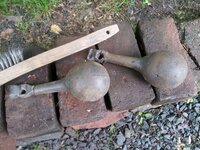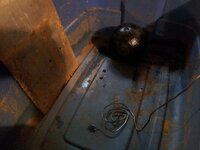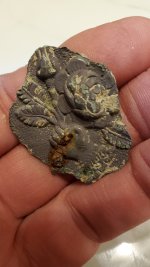Zodiacdiverdave
Silver Member
- Mar 18, 2011
- 2,765
- 1,371
- Detector(s) used
- XP Deus, AT Pro, Sea Hunter II, JW Fisher Proton Magnatometer, Shovel, Hammer and chisel
- Primary Interest:
- All Treasure Hunting
Saltwater finds differ from fresh water or land finds in that the salt molecules actually penetrate the artifact whether it be iron copper wood etc. the only exception is gold & lead. The more porous the object the more the saltwater will penetrate until it reaches the saturation point. I will only deal with ferous metal in this post. Cast & wrought iron are very porous, steel is less porous but it will also need to be treated in the same manner, even stainless steel will need to be treated. Other methods like putting them in a rain barrel or stream will only remove the salt near the surface but will not remove any salts that have penetrated the core of the item.
Here is some pix of some cast iron fly wieghts, the first pic I did to show the salts that have been pulled to the surface of the fly wieght using electrolysis. The second pic is a broken fly wieght from the same wreck that was allowed to dry out with out any treatment. the third pic are the results following final cleaning.
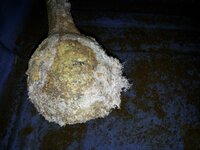
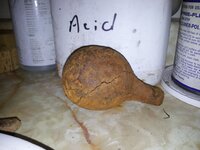
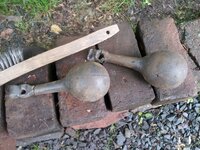
This is the sad result of not treeting an 18th century cannonball,
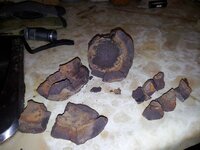
So the first step in treating a recovered object is to not let it dry out, "AT ALL". Keep the thing wet by any method, take your buddies shirt and soak it down and wrap your piece in it if you have to . When you get home put it in a pail of water and you can leave it there untill you can get at it, keep an eye on it so the water doesn't evaporate on you.
. When you get home put it in a pail of water and you can leave it there untill you can get at it, keep an eye on it so the water doesn't evaporate on you.
Set up your electrolysis system by using a manual battery charger and a tub deep enouph to submerge your item. Your anode will need to be stainless steel for this and to be quite substantial as it will be in the tank for months usually and anything less will quickly desolve. To connect the artifact use a wire lead attatched to the item and make sure it is in contact with clean metal. For cannonballs I use a wire coat hanger that has been sanded to remove the coating that is on it, and then bent up at the bottom to look like a stove element.
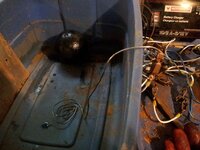
This will allow the CB to sit on the wire and make a good contact without having to drill it. Most cast iron objects that are recovered from saltwater are very fragile untill treated, by drilling and then trying to screw in a self taping screw on these items can result in a fracture as noted in this pic.
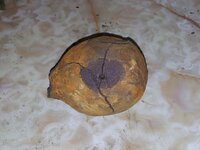
Next you have to prep the CB by wire brushing it to remove all organic matter and loose rust, then take a file and file an area clean so no rust or concreation will interfere with the contact point where it will sit on the coiled up coat hanger. Keep the object wet during this process by dunging it in water every now and then. Place the object on the wire or connect the item to a lead for that will extend out of the tub.
Make the electrolite by mixing 1 oz of baking soda per gal. of water, tap water is fine, and fill up the tub to cover the objects. Add enouph electrolite so that evaporation will not be to much of an issue.
Put the stainless steel anode in and make sure that it prodrudes out of the electrolite so the connection point is not touching the solution. Connect the positive lead of the battery charger to the anode and the negative lead to the artifact's wire or lead. Now you are ready to cook the items. I use the charger set at 2 amps and for a 32 pound CB I will cook it for 4-5 months, removing it every month and give it a good wire brushing and rotate the position of the item to allow for even cooking.
after the item has cooked long enouph the take the leads and switch the positive to the artifact and the negative to the anode and leave it like this for no more then 2 days. This will remove the salt molecules that have been pulled to the surface of the item. You can skip this proceedure and just set it on the bench for a week or so and the salts will grow on the suface as in my very first pic.
Following this procedure give it another good wire brushing and then you can dry and preserve the item by one of many ways, Hot waxing or hot oil, care must be used when using these methods, do not exceed 250*F when doing this and DO NOT DO THIS IN THE HOUSE! Watch Aquachigger's video.
You can also slow cook them on your gas grill or place them in a bag of kitty litter or disiccant like silica crystals. Once it has been dried the you can paint it or use a light oil or rust preventer to prevent any further surface rusting.
Good luck and PM me if you have any questions regarding salt water finds preservation. Also I recommend watching Aquachiggers video on using electolysis on land and freshwater finds. The main difference is that these types of finds only require a short amount of cooking time becuase they don't have the salt penetration issue.
I would like to say that I did not get permission from Aquachigger to link his excelent videos and I hope he does not mind but Beau if you do mind please let me know and I will remove the links.
After all this you notice any seat beads forming on the object you have treated the the whole process from scratch should be repeated.
HH,
ZDD
Here is some pix of some cast iron fly wieghts, the first pic I did to show the salts that have been pulled to the surface of the fly wieght using electrolysis. The second pic is a broken fly wieght from the same wreck that was allowed to dry out with out any treatment. the third pic are the results following final cleaning.



This is the sad result of not treeting an 18th century cannonball,

So the first step in treating a recovered object is to not let it dry out, "AT ALL". Keep the thing wet by any method, take your buddies shirt and soak it down and wrap your piece in it if you have to
 . When you get home put it in a pail of water and you can leave it there untill you can get at it, keep an eye on it so the water doesn't evaporate on you.
. When you get home put it in a pail of water and you can leave it there untill you can get at it, keep an eye on it so the water doesn't evaporate on you.Set up your electrolysis system by using a manual battery charger and a tub deep enouph to submerge your item. Your anode will need to be stainless steel for this and to be quite substantial as it will be in the tank for months usually and anything less will quickly desolve. To connect the artifact use a wire lead attatched to the item and make sure it is in contact with clean metal. For cannonballs I use a wire coat hanger that has been sanded to remove the coating that is on it, and then bent up at the bottom to look like a stove element.

This will allow the CB to sit on the wire and make a good contact without having to drill it. Most cast iron objects that are recovered from saltwater are very fragile untill treated, by drilling and then trying to screw in a self taping screw on these items can result in a fracture as noted in this pic.

Next you have to prep the CB by wire brushing it to remove all organic matter and loose rust, then take a file and file an area clean so no rust or concreation will interfere with the contact point where it will sit on the coiled up coat hanger. Keep the object wet during this process by dunging it in water every now and then. Place the object on the wire or connect the item to a lead for that will extend out of the tub.
Make the electrolite by mixing 1 oz of baking soda per gal. of water, tap water is fine, and fill up the tub to cover the objects. Add enouph electrolite so that evaporation will not be to much of an issue.
Put the stainless steel anode in and make sure that it prodrudes out of the electrolite so the connection point is not touching the solution. Connect the positive lead of the battery charger to the anode and the negative lead to the artifact's wire or lead. Now you are ready to cook the items. I use the charger set at 2 amps and for a 32 pound CB I will cook it for 4-5 months, removing it every month and give it a good wire brushing and rotate the position of the item to allow for even cooking.
after the item has cooked long enouph the take the leads and switch the positive to the artifact and the negative to the anode and leave it like this for no more then 2 days. This will remove the salt molecules that have been pulled to the surface of the item. You can skip this proceedure and just set it on the bench for a week or so and the salts will grow on the suface as in my very first pic.
Following this procedure give it another good wire brushing and then you can dry and preserve the item by one of many ways, Hot waxing or hot oil, care must be used when using these methods, do not exceed 250*F when doing this and DO NOT DO THIS IN THE HOUSE! Watch Aquachigger's video.
You can also slow cook them on your gas grill or place them in a bag of kitty litter or disiccant like silica crystals. Once it has been dried the you can paint it or use a light oil or rust preventer to prevent any further surface rusting.
Good luck and PM me if you have any questions regarding salt water finds preservation. Also I recommend watching Aquachiggers video on using electolysis on land and freshwater finds. The main difference is that these types of finds only require a short amount of cooking time becuase they don't have the salt penetration issue.
I would like to say that I did not get permission from Aquachigger to link his excelent videos and I hope he does not mind but Beau if you do mind please let me know and I will remove the links.
After all this you notice any seat beads forming on the object you have treated the the whole process from scratch should be repeated.
HH,
ZDD


